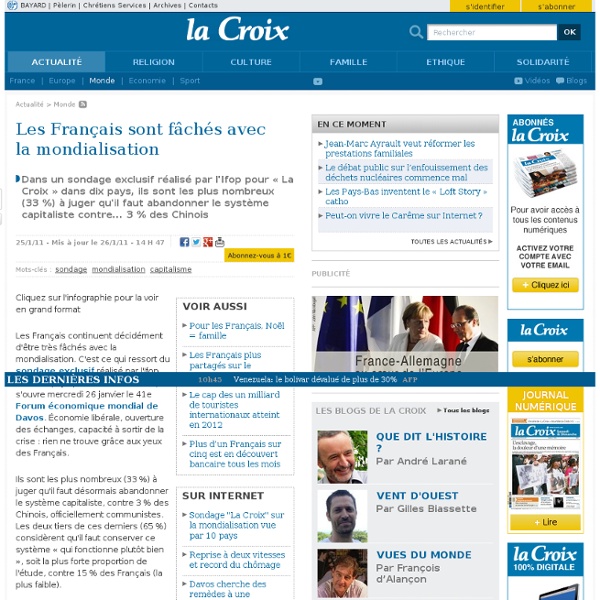Les Français sont fâchés avec la mondialisation - Monde - la-Croix.com

Why Davos Doesn't Matter
A decade ago, Davos was the most coveted invitation among the aspirants, wannabes and star-struck hangers-on of the world's power players. The annual shindig of the World Economic Forum in the Swiss Alpine ski resort assembled the corporate and political elites of the West — and those from the developing and former socialist worlds who were ready to accept their tutelage — to plot the future of globalization. The free market had become the uncontested economic model, free trade was the order of the day and dot-com visionaries promised that stock market exuberance was no longer irrational. The future seemed to belong to what Samuel Huntington (yes, he of the "Clash of Civilizations" fame) dubbed "Davos Man." The fact that this year's gathering opened under the cloud of a precipitous global stock market slide and creeping recession may be symbolically apt, but it is not the only reason for the absence of triumphalist illusions at Davos 2008.
Gulf petro-powers to launch currency in latest threat to dollar
The project is inspired by Europe’s monetary union, seen as a huge success in the Arab world. But there are concerns that the region is trying to run before it can walk. Europe took 40 years to reach the point where it felt ready to launch a currency. It began with the creation of the Iron & Steel Community in the 1950s, moving by steps towards a single market enforced by powerful Commission and European Court. Khalid Bin Ahmad Al Kalifa, Bahrain’s foreign minister, told the FIKR Arab Thought summit in Kuwait that the project would not work unless the Gulf countries first break down basic barriers to trade and capital flows. At the moment, trucks sit paralysed at border posts for days awaiting entry clearance. “The single currency should come last. Mohammed El-Enein, chair of the energy and industry committee in Egypt’s parliament, said Europe’s example could help the Arab world achieve its half-century dream of a unified currency, but the task requires discipline.
Moral Hazard and Capital Structure, Arnold Kling | EconLog | Lib
Russ Roberts is working on a paper suggesting that the fragility of our financial system could be the result of past bailouts, in which unsecured creditors and counterparties of financial institutions were always made whole. In some sense, the fact that the Fed fears contagion makes them turn such liabilities into ex post nearly riskless assets for investors. This reminded me of the history of the economics of corporate capital structure. My version of that history follows. Take a company with a given set of investment projects (you can think of my favorite example, fruit trees). Before economists got involved, the thinking was that shareholders could earn a higher return with more leverage (more debt). This thinking was challenged by Merton Miller and Franco Modigliani. In fact, the easiest way to think of the Modigliani-Miller theorem is to assume that a single investor owns both the debt and the equity of the firm. Next, we introduce tax costs and bankruptcy costs.
Related:
Related:



